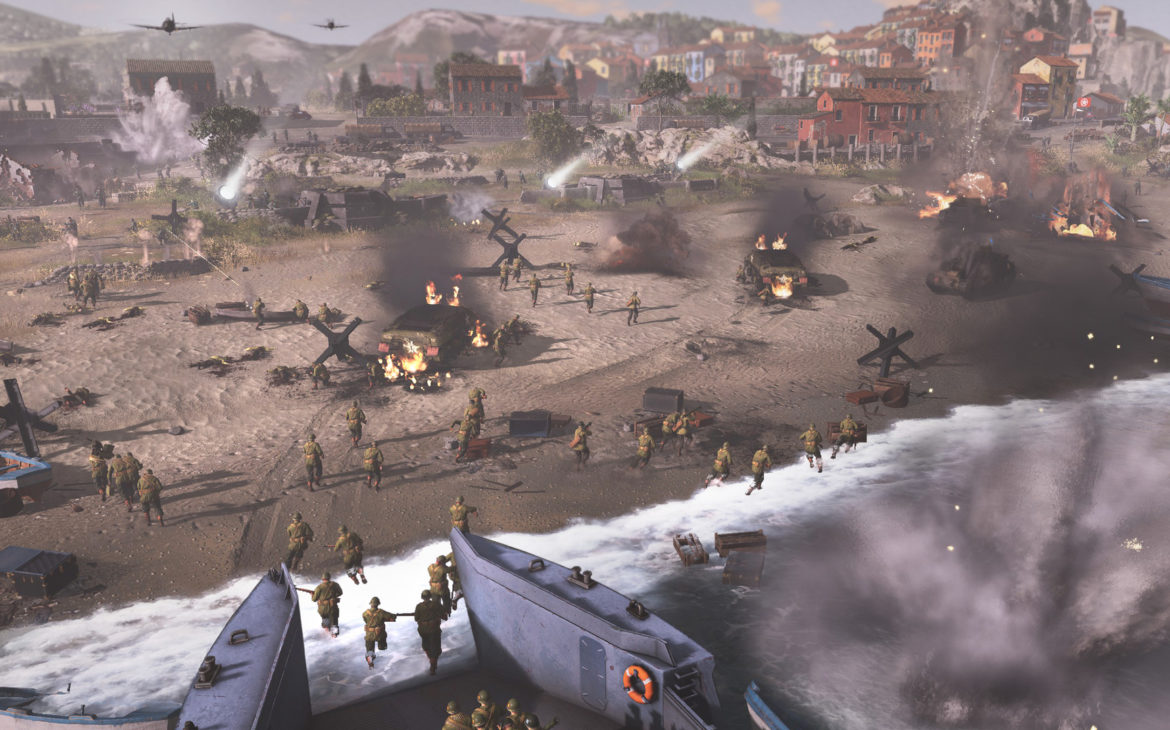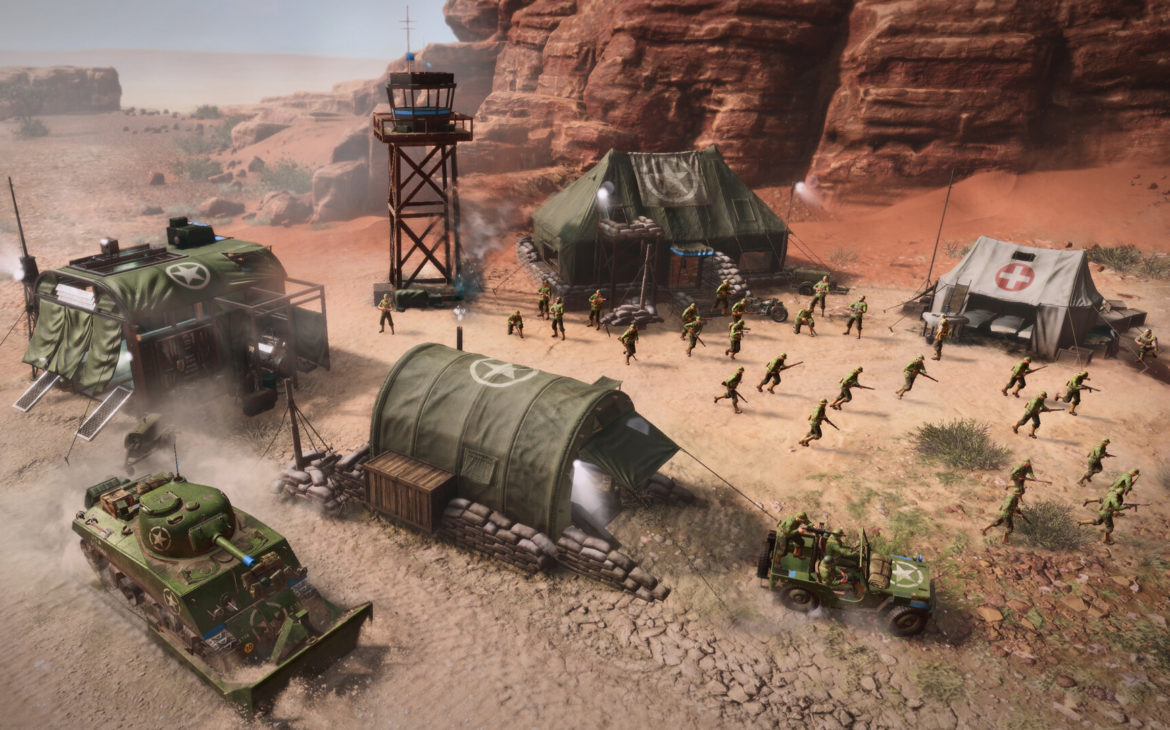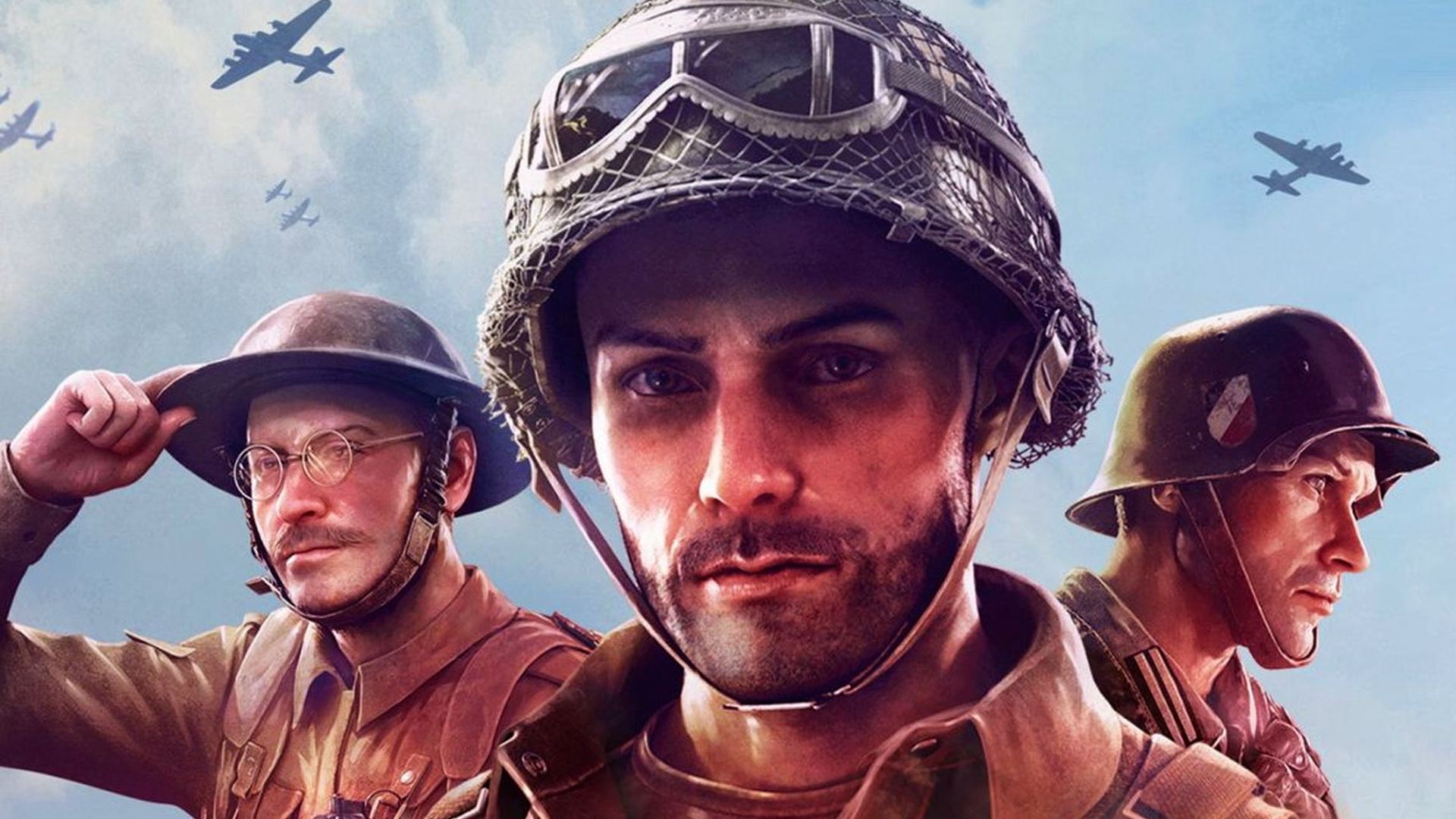I love Company of Heroes. Back in 2007 I was addicted to the first game and it helped my through quite a few years of my childhood, which has left me with a bit of a soft spot for the franchise. Company of Heroes 1 still holds up well even against some modern games, and Company of Heroes 2 was a flawed but extremely fun entry that solidified the franchise as a staple of my steam collection. It’s been a while since the last release but the next entry into the series, Company of Heroes 3, recently released. So how does it stack up compared to its predecessors?
Gearing Up For War
To begin with, Company of Heroes is a series which features real time tactical battles that take place in WW2. You command squads of soldiers and equipment from that conflict within engagements in a real time setting, where you need to take and hold land for resources such as manpower, fuel and munitions in order to fuel your war machine. Generally, infantry will cost manpower to requisition, fuel will be used to call in light armour and tanks, and munitions will be used for squad upgrades and abilities such as artillery barrages and air strikes. Finally, in single player you’ll need to capture objectives to advance your missions, and in multiplayer you’ll need to capture victory points to win the battle if you can hold the majority of them for long enough. You’ll also need to choose a company for each game to specialise in, which will give you access to unique units for that company, such as Panthers for the Wehrmacht armoured battlegroup or my personal favourite, the Guastatori Italian engineers from the Afrika Korps infantry company. It’s a good formula that worked well in both prior games and their respective expansions and it continues to work well here too.
Whereas the first game took place on the western front, and the 2nd game took the fight to the east, Company of Heroes 3 instead takes the fight to oft-forgotten theaters of the war; North Africa and Italy. The game launches with 2 different types of single player campaigns, as well as a multiplayer and single player skirmish mode, so on the surface there is a lot to do. Starting off with the single player modes, there are two types of campaigns set in North Africa and Italy. Both, as mentioned, are underrepresented areas of the war in popular media, and its good to see them take centre stage in a WW2 strategy game.
A Trip To The Mediterranean
The first campaign is a narrative campaign set in North Africa, with you taking control of the German Afrika Corps in several narrative driven scenarios. This campaign acts as somewhat of a tutorial for the game, introducing you to the mechanics needed to learn the game such as commanding squads, commandeering vehicles and repairing or salvaging equipment such as heavy machine guns or tanks. You’ll also get to use the new Italian units as well, a first for the Company of Heroes series and a fun addition to the game. Over the course of the campaign, you’ll take part in some of the famous battles of the North African conflict, such as at Tobruk and El Alamein, and make your mark on history. In between missions, you’ll hear the harrowing story of the Axis occupation of North Africa and its effect on the local populace – I thought the voice acting was pretty good and really added to the campaign, and the story itself was pretty heartbreaking and really brings home the reality of war. Overall, the North African campaign is a solid introduction (or re-introduction) to the Company of Heroes series, and I was overall impressed with how it sets the stage for the game for a new or returning player.
Next up is the second campaign in Company of Heroes 3, the Italian campaign. Meant as the bigger campaign of the 2 campaigns that ship with the game, the Italian campaign is a different beast compared to North Africa. This time you’ll be taking control of the Allies: both the British and Americans will be under your command, with Italian Partisans also eventually being able to commanded, and you will fight to push the Germans back to liberate Italy from the Axis yoke. Unlike the North Africa campaign, It is not a traditional campaign with a bunch of scenarios linked together, but instead is akin to something like the Total War series. You have a grand turn based campaign map you’ll move your armies on in Italy starting in the south, and when they meet an enemy army or position you’ll initiate a real time tactical battle on the battlefield. Some of these are general skirmish battles similar to what you’ll play against bots in skirmish mode, but certain important sectors have a special scenario you need to complete in order to liberate them. To complete these missions, you’ll need armies.

Choosing The Right Tool
Armies are the primary tool at your disposal, and you will need to use them well in order to secure the liberation of Italy. To begin with, you’ll need to secure Sicily in a quick tutorial scenario, but after this you’ll then advance onto the mainland. To do this, you’ll be granted a British Armoured Division and use it to start your assault, but later on you’ll get other divisions such as American special forces, British divisions from across the empire and Italian partisans to support you. These new armies can be recruited over time and will allow you to advance more easily each turn, as more divisions mean you can complete more actions per turn.
Each division in the Company of Heroes 3 Italy campaign will only have 1 action per turn, and this is used to destroy any obstacles put in your way or capture objectives such as towns or airports. The obstacles you may encounter are numerous – bunkers, anti-tank positions, artillery and so on – all can cause damage to your divisions over time if you leave them be or move into their line of fire instead of flanking. This can be a problem, as your division will be less useful over time if it takes too much damage to its health, and destroyed if it goes to 0. To avoid this, you can reinforce your division but it will be rendered combat ineffective for a turn so it can’t take any of its actions.
Over time, you can improve your division with extra abilities, being able to call in addition and more specialised troops, or can unlock more abilities to allow for more tactical possibilities such as artillery barrages or recon flares. These help to make each division a bit more distinct from each other, and make them stronger over time – some of these units, such as the Australian infantry and Archer tank destroyer, aren’t even available for multiplayer use yet. In addition, if you can keep the three factions (British, American and Italian Partisans) happy you’ll gain more buffs over time to your forces, further increasing their effectiveness. Lastly, you can also call in air strikes and shore bombardments from support elements such as battleships, bombers and aircraft carriers which can help you both on the campaign map and in the tactical battles. All of these further add to your options to deal with any particular situation.
It’s a fun mix, but unfortunately it just doesn’t grab me as much as I hoped it would. The campaign overall just feels tedious to complete, and it just felt more like I was going through the motions rather than having fun – this was compounded by the AI in the Italy campaign being especially dumb, making suicidal attacks and being very easy to beat in the tactical battles. I think there is a solid chassis for them to build upon here, however, and it is going to be very interesting to see what they can do in future with these systems if they iterate upon them well.

Testing Your Mettle
Next up is the multiplayer, and it features 4 factions which showcase many of the units you’ll have seen in any of the single player campaigns if you tried them. First up are the Brits, who field troops from across the Commonwealth and have a wide selection to choose from, including units often not seen in video games. From the usual infantry sections, to the 6 and 17 pounder anti tank guns, mortars of various ilk, all the way up to heavy armour like the Churchill and the Matilda 2. The latter in particular is one of my favourite units, and is available in the basic production buildings instead of the various battlegroups you get to choose from. Overall, the Brits are a solid faction, especially in the midgame but even in lategame with judicious use of their great infantry selection, and I really enjoyed playing as them due to the unique units they possess which are not as prominent in most media like the aforementioned Matilda 2.
The other allied nation available in multiplayer are the Americans, and they also bring a nice selection of troops to the field. From your basic rifleman, to bazooka squads, to Sherman tanks and beyond – most of the units present are more common in video games compared to the Brits, but still fun to use. I do feel that the Americans were the weakest faction to play for my personal playstyle, which relied on heavy armour and excellent infantry a lot, but in the hands of a skilled player they’re still a powerful faction to command. They excel in combined arms warfare and are able to utilise powerful support abilities from their battlegroups to swing the situation to their advantage. Late game, they don’t quite have the punch of the Brits but can still throw their weight around plenty in the hands of a proficient player.
Next up is the first of the Axis factions, the Wehrmacht. They again showcase more of the common units you’ll see in WW2 strategy games, with units from Grenadiers to Panzergrenadiers, Pak 40’s and Panzer 4’s and Panthers your instrument to exert your will upon the battlefield. Just because they’re more common doesn’t make them weak, though, and they’re a late game powerhouse once they can start flooding the field with plenty of heavy armour. Their battlegroups are mostly armour focused and their late game reflects this, and I hope future battlegroups do add options for additional playstyles for player to revolve their play around.
Finally, the second Axis factions is the Afrika Korps, and they are the more unique of the two. Unlike the Wehrmacht, which only features German units, the Afrika Korps is also able to bring Italian units to the battle and they’re extremely fun to use. They also rely on lighter armour and infantry until the late game, with their strongest unit in their base buildings being a Panzer 3, but once you’ve completed some late game research you will be able to bring Panzer 4’s and Tiger 1’s onto the field. These were fun to use, but I still had the most fun in the game whilst using the Italian infantry and combined arms battlegroups. Overall, this was probably my favourite faction, followed very closely by the British.
An Unbalanced Experience
In Company of Heroes 3, the balance in both single player and multiplayer does have a few issues however. In single player modes, the AI is either overall pretty weak and easy to beat, or extremely difficult on the higher setting of skirmish modes as they get so many extra resources. There isn’t really an intermediate AI which is challenging but beatable by the average person. I’m hoping that this is something they can improve on moving forward so that the AI can pose a legitimate challenge without being overwhelming.
The multiplayer balance is also a bit all over the place. Time to kill seems very low, with units dropping like flies when focused, which isn’t a bad thing but does make the game feel very quick compared to CoH 2. Generally, after the very early game blobbing becomes very prevalent with infantry units, and there are some combinations of units, such as British infantry units en-masse upgraded with Boys anti tank rifles, that are really hard to counter unless you have heavy armour or a good amount of artillery. Crushing of infantry by armour, which helped to balance this in CoH 2 and make players spread their units out a bit, has unfortunately been removed. Some of the factions also feel a lot stronger than the others with their base units instead of the units from their battlegroups. Speaking of Battlegroups, you get 3 choices in each game to choose from, and there are only 3 Battlegroups in the game for each faction – this is far less than what is now available in CoH 2 and I think even at launch, and more variety would be nice considering this is a full price AAA game in cost for PC players.
That said, the multiplayer in Company of Heroes 3 is still the highlight of the game, and I had a blast playing multiplayer games, especially the bigger team games. The MP mode supports up to 4 vs 4 games, and these tended to be where I would ply my trade. The matchmaking did take a while sometimes, but the games were worth it to get into and the fun element definitely holds up in comparison to previous games for this particular game mode. There are 14 maps that ship in the game, spread across 1v1 – 4v4 game modes, but the modding tools that come with the game and the steam workshop integration at launch hopefully mean more will be coming for the community to play soon.
A March To Victory… Or Defeat?
The visuals, audio and general performance in Company of Heroes 3 are a mixed bag as well. In general, I think the performance is excellent, with my older PC having absolutely zero issues running the game at a high framerate, with zero stutters or frame rate issues. The game pays a price to do this however, as the visuals don’t push the performance envelope as much as the previous two games did and looks decidely ‘last generation’ at times. In addition, the art style isn’t something I’ve 100% gelled with, and I think its to do with the lighting – the units you use in the game look like they’re made out of plastic and are toys as opposed to actual soldiers. Finally, the audio is decent but it didn’t blow me away – explosions and general gunfire and the surrounding audio didn’t feel as visceral as I would of like. It’s not bad, but I wouldn’t say its great either.
Company of Heroes 3 is a solid, but flawed, new entry into the series. The multiplayer especially is still amazingly fun, but there are a plethora of balance issues that need to be solved for it to truly shine. In addition, the single player modes are in many ways a bit lacking and even at times a bit boring. It requires more refinement, but if Relic can improve the AI, and build upon their Italy campaign, then the future is bright for the Company of Heroes franchise.

Company of Heroes 3 is available now on PC via Steam
Developer: Relic Entertainment
Publisher: SEGA
Disclaimer: In order to complete this Review, we were provided with a promotional code from the publisher. For our full review policy, please go here.
If you enjoyed this article or any more of our content, please consider our Patreon.
Make sure to follow Finger Guns on our social channels. Twitter, Facebook, Twitch, Spotify or Apple Podcasts – to keep up to date on our news, reviews and features.
